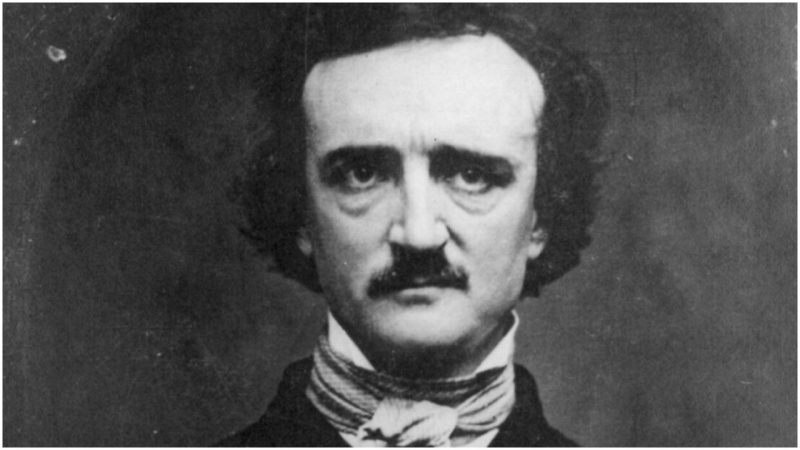It’s a mystery the father of detective fiction may have penned himself: On a dark and stormy election night in 1849, a newspaperman hurrying to Ryan’s 4th ward polling place in Baltimore came upon a man lying in a gutter outside the public hall. The man was dirty, disheveled, and barely coherent. When the newspaperman stopped, he received quite a shock: this filthy, seeming stumblebum was the estimable poet and detective writer, none other than Edgar Allan Poe.
Quickly the newspaperman sent a message to a Poe associate describing Poe as “the worse for wear,” “in great distress,” and “in need of immediate assistance.”
Though Poe was hurried off to Washington College Hospital, he dipped in and out of a feverish and hallucinatory consciousness, at one point calling out for “Reynolds”—another unexplained mystery. He never regained full lucidity and died four days later, at age 40, on October 7, 1849, reportedly of “phrenitis,” or swelling of the brain.
What caused the writer of “The Tell-Tale Heart” to land in a gutter and never recover? Was he drunk, sick, or beaten to death? “Maybe it’s fitting that since he invented the detective story,” Chris Semtner, curator of the Poe Museum, in Richmond, Virginia, told Smithsonian magazine. “He left us with a real-life mystery.”
Edgar Allan Poe was born January 19, 1809, in Boston, the son of two actors. His early life was marked by loss. His father abandoned the family when Edgar was an infant; his mother died of tuberculosis two years later. He was raised in Richmond, Virginia, by a Scottish merchant, with whom had many disagreements over money. Poe attended the University of Virginia briefly, dropped out and enlisted in the Army, where he spent two years and published his largely ignored first book of poetry.
Poe attended West Point, where he published another book of poetry, but he chafed at the discipline and successfully got himself kicked out. In 1835, he became a magazine editor and a literary critic known for harsh appraisals. When he was 27, he fell in love with and married his cousin Virginia Clemm, then 13, and the couple moved to New York. In 1841, he published the story “The Murders in the Rue Morgue,” often cited as the first modern detective story.
Poe achieved more universal acclaim when he published his dark and hypnotic poem “The Raven,” in The New York Evening Mirror in 1845. It was around this time that Virginia started coughing blood—a terrible tell-tale sign of tuberculosis. When she died in 1847, Poe fell into a deep, alcohol-fueled despondency from which his friends feared he would never recover. He became engaged nearly two years later, but his fiancée insisted he quit drinking, and he couldn’t. Indeed, for many years people assumed that alcoholism felled him.
Setting the scene for the events that led to his death, Poe spent the summer of 1849 in Richmond, proposing to his childhood sweetheart, Sarah Elmira Royster. On September 27, 1849, he left Royster in Richmond and set off to Philadelphia, where he was to help a friend edit a collection of poems. He never arrived, and no one knew where he was until the newspaperman found him October 3 outside the polling place.
Was Poe inebriated? He was highly susceptible to the effects of alcohol, and even a couple of drinks could’ve made him blind drunk. In 1867, one of his first biographers theorized that thugs may have beaten him in his drunken state. Others speculated that he was a victim of the 19th century voter-fraud practice of “cooping,” whereby a man, persuaded by alcohol, was forced to vote multiple times under different aliases at multiple locations.
Other suppositions include poisoning—by carbon monoxide or heavy metal—but DNA testing of Poe’s hair clippings have largely discredited those theories.
In the September 1996 issue of Maryland Medical Journal, Dr. R. Michael Benitez published an article pulling together facts that suggested Poe had died from rabies.
Most recently, historians have surmised Poe may have had a brain tumor. When Poe’s remains were exhumed 26 years after his death for relocation, the rotted coffin unfortunately fell apart. Observers noted a mass in his skull, and assumed it was his brain. Today forensics experts know the brain would’ve disintegrated in two decades, but a tumor would remain intact. Pressing on the brain, a tumor can cause erratic behavior and stuttering incoherence easily mistaken for drunkenness.
“I’ve never been completely convinced of any one theory,” Semtner, the Poe Museum historian, told Smithsonian.
Will we ever really know how Poe died?
If you asked his Raven, you know the answer: NEVERMORE.
